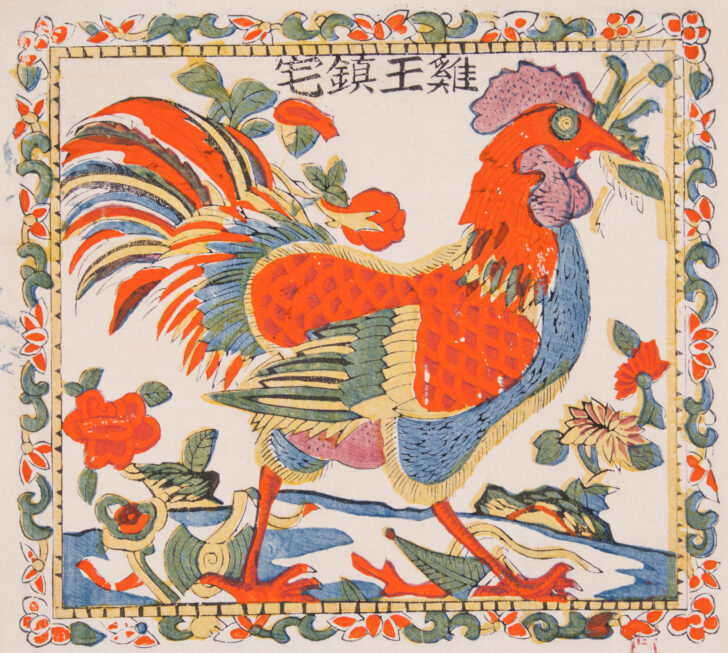The Rooster Protects the House from Suzhou
Chinese

Description
As early as the sixth century AD, it was customary in China to paste an image of a rooster on the door on the first day of the lunar New Year to protect the household. The rooster is associated with the sun, and the idea that at cockcrow all darkness of evil disappears. The rooster is also holding a mantis in its beak, making a rebus (or pictorial pun). The pronunciation of the characters for “mantis” (tanglang) are similar in sound to those for “promotion to a high official post” (dang lang), implying that the rooster brings good fortune to the family. In addition, the pronunciation of the character for “rooster” (ji) is identical to that for “auspicious.” Other propitious motifs in this print include a branch of red coral (for wealth), a red peony (for honor) and a pointed green Artemisia leaf (the strong scent provides protection against evil).
This custom continues today as Chinese homes are brilliantly decorated with door gods (menshen), wealth deities, and “luck-bringing papers” in preparation of the lunar New Year—the last day of the twelfth moon.
(Label for UMMA Chinese Gallery Opening Rotation, March 2009)
Subject Matter:
As early as the sixth century AD, it was customary in China to paste an image of a rooster on the door on the first day of the lunar New Year to protect the household. The rooster is associated with the sun, and when the rooster crows it is believed that all darkness of evil disappears. The rooster holds a mantis in its beak. The pronunciation of the characters for "mantis" (tanglang) are similar in sound to those for "promotion to a high official post" (dang lang), implying that the rooster brings good fortune too the family. In addition, the pronunciation of the character for rooster (ji) is identical to that for "auspicious." Other, propitious motifs in this print include a branch of red coral (for wealth), a red peony (for honor) and a pointed green Artemisia leaf (whose strong scent provides protection against evil).
Physical Description:
Polychrome woodblock print of a rooster holding a praying mantis in its mouth with four characters at top center framed by a floral scrolling border
Usage Rights:
If you are interested in using an image for a publication, please visit https://umma.umich.edu/request-image/ for more information and to fill out the online Image Rights and Reproductions Request Form.